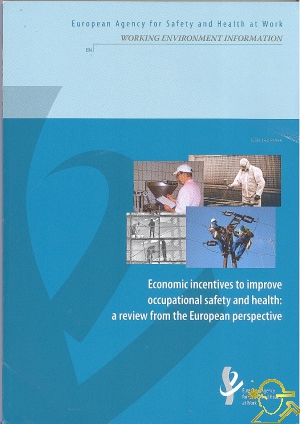 |
 |
 |
Economic incentives to improve occupationalsafety and health:a review from the European perspective
|
Book : Economic incentives to improve occupationalsafety and health:a review from the European perspective Author : * -- Language : English Library : Health-Safety-Environment Publish Place : İspanya ISBN : 978-92-9191-299-5 Publish Date : 00 2010 Publisher : European Agency for Safety and Health at Work Original Language : Turkish Book Type : Book Book Number : 6853 |
 |
INDEX
Table ofContentsForevvord
Executive summary
Summary: literatüre review
Summary: policy overvievv
Summary: case studies review
List of acronyms and abbreviations
l.lntroduction....
1.1. Terminology
2. Literatüre revievv
2.1. Introduction
2.2. Identification of relevant literatüre
2.3. Literatüre revievv
2.3.1. Existing EU, ILO and expert group reports
2.3.2. Scientific overvievvs and evaluations of economic incentives for OSH ..
2.3.3. Country-, sector- and case-specific studies on economic incentives for OSH prevention in enterprises
2.3.4. Economic incentives for OSH in SMEs
2.4. Summary of main resultsofthe literatüre revievv
2.5. Conclusions
2.6. References
2.7. Annexes
3. Policy overvievv
3.1. Introduction
3.1.1. Methodology
3.2. Policy classifications
3.2.1. Background
3.2.2. VVelfare systems
3.2.3. Beveridge versus Bismarck
3.2.4. VVorkers' compensation insurance
3.3. Economic incentives
3.3.1. Introduction
3.3.2. İnsurance strategies
3.3.3. Tax and funding schemes
3.3.4. Non-fınancial incentives
3.4. Conclusions
3.5. References
3.5.1. General
3.5.2. Country-specific
3.6. Annexes
3.6.1. Annex 1: Overvievv of legal framework and vvorkers' compensation scheme in each EUMember State
3.6.2. Annex 2: Overvievv of rating systems in each EU Member State
3.6.3. Annex 3: Overvievv of economic incentives in OSH
(other than insurance-based incentives) in each EU Member State
4. Case studies revievv
4.1. Introduction
4.2. Insurance premium variation
4.2.1. Statutory Accident Insurance of the Butchery Industry (Germany)
4.2.2. Snapshot: The SME Indicator (United Kingdom)
4.2.3. Premium Discount Programme in the Farmers' VVorkers'Compensation Insurance (Finland)..
4.2.4. Reduction of companies' compulsory insurance premium follovving
prevention support measures (İta ly)
4.2.5. Snapshot: Premium differentiation in occupational accident insurance (Belgium)
4.2.6. Enterprise for Health: Promoting health management among companies in
Lovver Saxony (Germany)
4.2.7. Snapshot: Farm Health and Safety Initiative (Ireland)
4.3. State subsidies, grants
4.3.1. Supporting SMEs in OSH management (Poland)
4.3.2. Promoting a systematic approach to OSH management in Polish enterprises (Poland)
4.3.3. Lovv-cost consultancy for safety and health management (SGM) by Austrian SMEs (Austria)..
4.3.4. Snapshot: Funding health promotion activities (Austria)
4.3.5. The Prevention Fund (Denmark)
4.3.6. Business financing for programmes and projects in occupational safety and hygiene (İtaly)
4.3.7. The Experience Fund (Belgium)
4.3.8. Subsidies for innovative work equipment: the FARBO regulation (Netherlands)
4.4. Incentive based on internal evaluation ofcost-benefit
4.4.1. Snapshot: The TYTA Model (Finland)
4.5. Summary of case studies
4.6. Overvievv of case characteristics
5. Condusions
5.1. Introduction
5.2. Summary: Literatüre revievv
5.3. Summary Policy Overvievv
5.4. Summary Case Studies Revievv
5.5. Overall Condusions
5.5.1. Evaluation
5.5.2. What kinds of incentives fit vvith vvhich social systems? 5.5.3 Success factors for economic incentives
5.6 References


